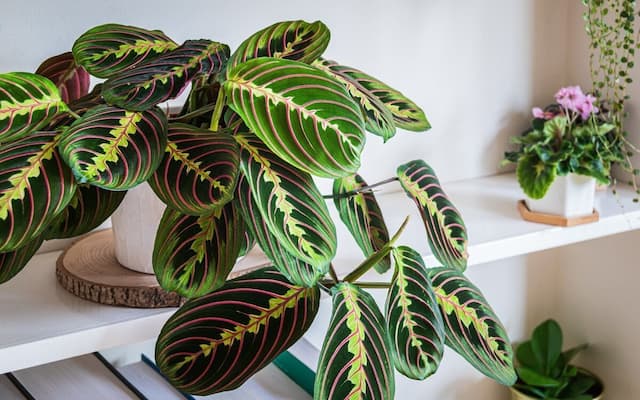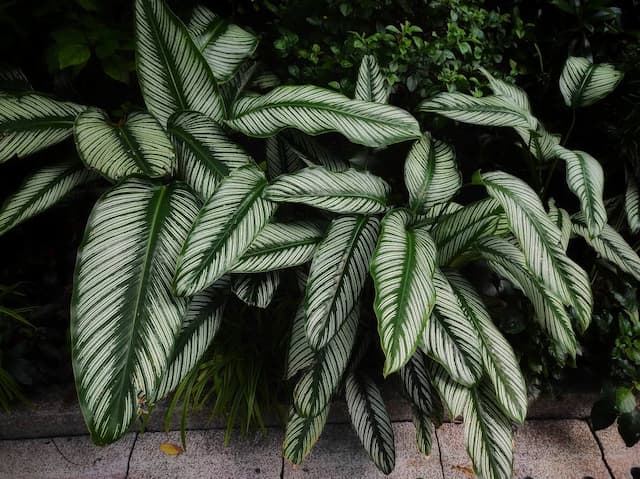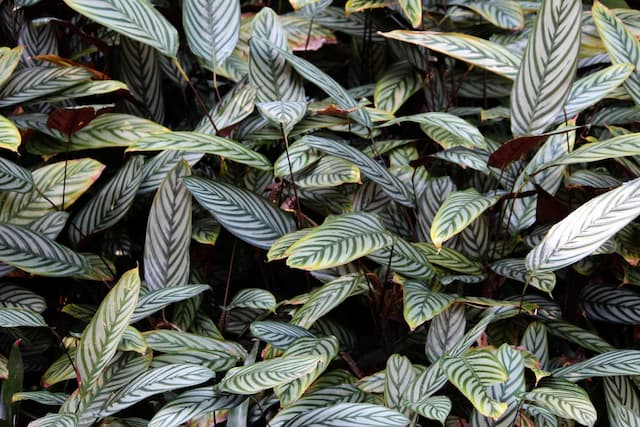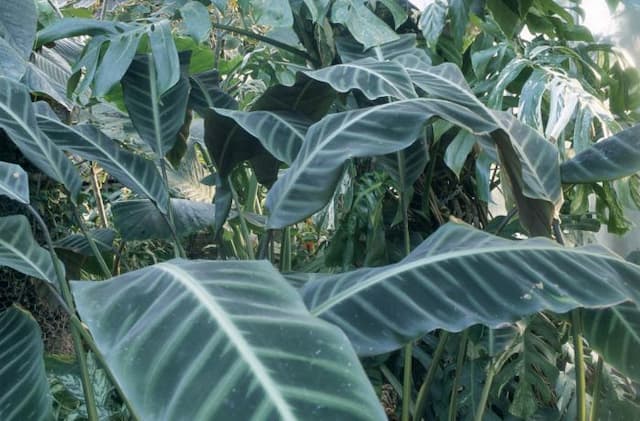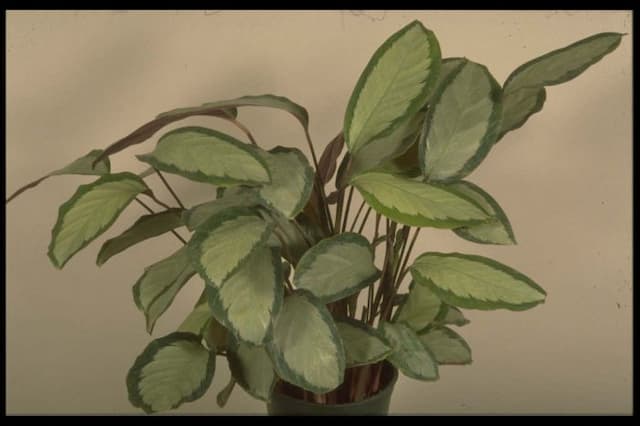Rose-painted calathea Goeppertia roseopicta



ABOUT
Goeppertia roseopicta is a species of flowering plant in the Marantaceae family. It is native to South America and is commonly grown as a houseplant in other parts of the world.
Goeppertia roseopicta has large, decorative leaves that are typically green in color with pink or purple markings. The leaves are oval in shape and are borne on long, thin stems. The plant produces small, white or pink flowers that are not very showy and may be hidden among the foliage.
Goeppertia roseopicta is a low-maintenance plant that is well-suited to growing indoors in a pot. It prefers a warm, humid environment and should be kept in a location with indirect sunlight. The plant requires regular watering, but it should not be overwatered, as this can cause the leaves to yellow and wilt. Goeppertia roseopicta is often grown for its attractive foliage, which adds a tropical touch to any room.
About this plant
 Names
NamesFamily
Marantaceae
Synonyms
Calathea, Jungle velvet, Jungle rose
Common names
Calathea roseopicta, Calathea illustris, Maranta illustris, Maranta roseopicta, Maranta wagneri, Phyllodes roseopicta, Calathea 'Roseo Picta'
 Toxicity
ToxicityTo humans
Goeppertia roseopicta is not toxic to pets. This plant is safe for animals and can be kept in a household with children without any risk of poisoning. However, it is always a good idea to keep all plants out of reach of kids, especially if they are known to chew on or ingest plants. This will help prevent any accidental ingestion of plant material that could potentially cause digestive issues.
To pets
Goeppertia roseopicta is not toxic to animals. This plant is safe for animals and can be kept in a household with pets without any risk of poisoning. However, it is always a good idea to keep all plants out of reach of pets, especially if they are known to chew on or ingest plants. This will help prevent any accidental ingestion of plant material that could potentially cause digestive issues.
 Characteristics
CharacteristicsLife cycle
Perennials
Foliage type
Evergreen
Color of leaves
Green with pink or purple markings
Flower color
White, pink
Height
Up to 2 feet
Spread
Up to 2 feet
Plant type
Herb
Hardiness zones
9
Native area
South America
Benefits
 General Benefits
General BenefitsGoeppertia roseopicta has large, decorative leaves that are typically green in color with pink or purple markings. The leaves are oval in shape and are borne on long, thin stems;
It is known for its ability to remove toxins from the air, making it a good choice for improving the air quality in a room;
Goeppertia roseopicta is often grown for its attractive foliage, which adds a tropical touch to any room. The small, white or pink flowers are not very showy, but they add a touch of color to the plant;
Rose-painted calathea is a low-maintenance plant that is well-suited to growing indoors in a pot. It requires regular watering, but it is not demanding in terms of other care requirements. Medical Properties
Medical PropertiesIt is not commonly used in traditional or modern medicine, and there is no scientific evidence to support the use of this plant for medicinal purposes.
 Air-purifying Qualities
Air-purifying QualitiesRose-painted calathea is a member of the Marantaceae family, which is known for its air purifying qualities. Goeppertia roseopicta is known to remove toxins from the air, such as formaldehyde, benzene, and trichloroethylene.
 Other Uses
Other UsesSome people believe that Goeppertia roseopicta has mosquito repellent properties. While there is no scientific evidence to support this claim, some people may find that placing the plant in a room helps to deter mosquitoes;
While Goeppertia roseopicta is known to prefer a humid environment, some people believe that it can help to reduce the humidity in a room. This may be due to the plant's ability to remove moisture from the air through the process of transpiration.
Interesting Facts
 Feng Shui
Feng ShuiIn feng shui, plants are considered to have a positive influence on the energy (chi) in a space. Goeppertia roseopicta is believed to bring a sense of peace and balance to a room. Here are a few ways to use Goeppertia roseopicta in feng shui:
Place the plant in the east or southeast area of a room to bring prosperity and abundance;
Place the plant in the south area of a room to bring good fortune and success;
Place the plant in the north area of a room to bring career success and opportunities;
Place the plant in the west or northwest area of a room to bring creativity and blessings. Zodiac Sign Compitability
Zodiac Sign CompitabilityGEMINI
As a curious and easily distracted Gemini, you thrive on dualities and are drawn to plants with two stems or leaves with contrasting colors. The Calathea roseopicta, also known as the rose-painted calathea, is the perfect choice for you with its striking variegated leaves in shades of pink and white on top and deep purple underneath. This tropical plant is sure to capture your attention and add some flair to your space, all while being low-maintenance and fitting seamlessly into your busy lifestyle. Plant Symbolism
Plant SymbolismIn general, plants are often associated with life, growth, and renewal. They can also symbolize nature and the natural world.
The Calathea roseopicta, with its vibrant and colorful leaves, may symbolize beauty, vibrancy, and a sense of excitement or playfulness. It may also be seen as a symbol of the tropical regions where it is native, evoking feelings of warmth, relaxation, and escape.
 Water
WaterCalathea roseopicta plants, also known as rose-painted calathea, should be watered once a week on average.
However, the frequency of watering may vary depending on a number of factors, including the size of the plant, the size of the pot, the humidity level, and the temperature of the room. To determine the correct watering schedule for your Calathea roseopicta, it is important to monitor the soil moisture level. Stick your finger about an inch into the soil to check for moisture.
If the soil is dry at this depth, it is time to water. If the soil is still moist, wait a few more days before watering. By keeping the soil consistently moist, but not soggy or waterlogged, you can help your Calathea roseopicta thrive. Light
LightRose-painted calathea plants, also known as rose-painted calathea, prefer medium to low light conditions. They will tolerate some direct sunlight, but it is best to keep them out of direct, hot sun to avoid scorching their leaves. In general, it is best to place Calathea roseopicta plants in a location that receives bright, indirect light or dappled sunlight.
 Temperature
TemperatureRose-painted calathea, prefer warm temperatures between 70 - 85°F.
They will tolerate some fluctuations in temperature, but it is best to keep them away from drafty areas or extremes of heat or cold. In general, Calathea roseopicta plants do best in rooms that are kept at a consistent, comfortable temperature for humans. Pruning
PruningOnly dead and damaged leaves are pruned. Prune your plant in the spring or early summer when the plant is actively growing.
 Cleaning
CleaningAs needed
 Soil
SoilRose-painted calathea prefers soil that is well-draining and has a slightly acidic pH of around 6.0 to 6.5.
To create the ideal soil mixture for your Calathea roseopicta plant, you can start with a potting mix that is specifically formulated for indoor plants. To improve drainage, you can also add a small amount of perlite or coarse sand to the mix. It is important to avoid using soil that is too heavy or dense, as this can lead to problems with drainage and root rot. Repotting
RepottingWhen it comes to repotting Calathea roseopicta plants, the timing and frequency will depend on the size and age of the plant, as well as the size of the pot it is growing in. As a general rule, Calathea roseopicta plants should be repotted every 2-3 years, or when they outgrow their current pot and become pot-bound.
You can generally tell when a Calathea roseopicta plant needs to be repotted when the roots start to grow out of the drainage holes in the bottom of the pot, or when the soil dries out more quickly than usual. In general, it is best to repot Calathea roseopicta plants in the spring or early summer, when the plant is actively growing. Humidity & Misting
Humidity & MistingA humidity level of around 50% is ideal for Calathea roseopicta plants, although they can tolerate a slightly wider range of humidity levels. If you are having trouble maintaining the proper humidity level for your Calathea roseopicta plant, you can also consider growing the plant in a terrarium or greenhouse, where the humidity is naturally higher.
 Suitable locations
Suitable locationsIndoor
All year round
Outdoor
Rose-painted calathea are generally grown as indoor plants.
They are native to the tropical rainforests of South America, where they thrive in humid, warm environments with bright, indirect light. In order to replicate these conditions as closely as possible, it is best to grow Calathea roseopicta plants indoors in a pot.
However, if you live in a warm, humid climate with indirect light, it may be possible to grow Calathea roseopicta plants outdoors in a shaded area.Hardiness zone
10 - 11 USDA
 Life cycle
Life cycleRose-painted calathea is a perennial plant, meaning that it lives for more than two years and typically has a life span of several years to a decade or more.
This plant is typically an evergreen, meaning that it retains its leaves and remains active throughout the year. However, it may slow its growth or stop producing new leaves during periods of stress, such as when it is not receiving enough light or water.
It may produce flowers, although these are not particularly showy and are not the main reason for growing this plant. Propogation
PropogationPropogation time
Late spring - early summer
By STEM CUTTINGS:
Take a stem cutting from an existing plant and remove the lower leaves. Place the stem cutting in a pot filled with soil or in a jar of water. Keep the soil or water moist and place the pot or jar in a location with indirect light.
By DIVISION:
If your Rose-painted calathea has multiple stems or "pups", you can divide the plant by carefully separating the pups from the main plant and planting them in separate pots.
By ROOT CUTTINGS:
Take a cutting from the root of the plant and place it in a pot filled with soil. Keep the soil moist and place the pot in a location with indirect light.
By SEEDS:
You can also propagate Rose-painted calathea from seeds, although this method can be more challenging and may not always produce plants that are identical to the parent plant. To propagate from seeds, you will need to collect seeds from the plant and plant them in a pot filled with soil. Keep the soil moist and place the pot in a location with indirect light.
 Pests
PestsSpider mite
 Diseases
DiseasesRoot Rot, Powdery mildew, Bacterial leaf spot, Rust
